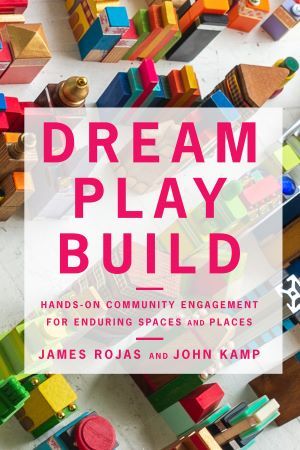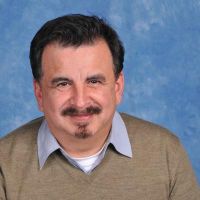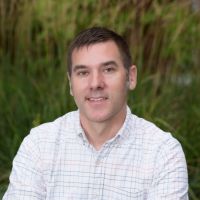Are You A Vanguard? Applications Now Open
graphixchon/iStock photo
This is your first of three free stories this month. Become a free or sustaining member to read unlimited articles, webinars and ebooks.
Become A MemberEDITOR’S NOTE: The following is an excerpt from the book “Dream Play Build: Hands-On Community Engagement for Enduring Spaces and Places,” by James Rojas and John Kamp, published by Island Press. In it, the authors argue for shaking up the traditionally hidebound and often acrimonious community meeting format, proposing instead a model of community engagement that inspires connection, creativity, and fun.
From 2005 to 2008, I worked as a city planner and urban designer for the City of Los Angeles. When I scan through memories of my post-community-meeting drives home during those years, the recurring theme is a feeling of acute hopelessness. In one instance, I was driving down the I-10 freeway back from Venice after making a presentation, in the gym of a community center, on a new design overlay for one of the ugliest streets in the United States, Lincoln Boulevard. We had put together a thoughtful presentation on, among other topics, urban design principles regarding street-width-to-building-height ratios that make for a more satisfying pedestrian experience; on zoning and how it affects building uses and heights; and on the concept of mixed-use buildings (retail on the ground floor, housing up top). The objective of these presentations was always the same: educate the public in core planning concepts so that they could move beyond thinking about traffic and lack of parking and too much density. Upon this planned-for awakening, the residents would then offer up thoughtful ideas regarding building heights and street widths, zoning, mixed-use, and other core planning concepts of our age. A perfectly sensible approach, we thought.
I distinctly remember how, after the presentation and during the Q-and-A session on that particular evening, a woman jumped the comment queue, stormed the podium, and proceeded to yell, “I’ve got something to say! I’ve got something to say!” What then unfolded was a tirade about having to walk past a trailer park on her way to Whole Foods with her kids and how that just wasn’t right and that something needed to be done about that. Other comments, while less vociferous, centered on less traffic, more parking, and keeping building heights low and without any new housing.
On another evening, for another design overlay, we gave a presentation to local residents about what a community design overlay is and then broke out into stations where residents could come up and ask us more specific questions. I was stationed behind a table labeled “Site Planning.” A local resident who described herself as an artist parked herself in front of the table and pointed to an area on a map of downtown San Pedro and said confidently, “I’m going to be building a huge sculpture here — as big as the Statue of Liberty. It’s going to be like the Statue of Liberty, except” — and here her eyes got wide — “sexier.” She paused for dramatic effect and continued: “Yes, sexier. Because this is Los Angeles. It’s going to be a man” — another pause — “wearing” — pause, wide eyes — “tight jeans … with maybe a cape, and a guitar with lasers shooting out of it.”
Midway through her description of her planned project, I started to hear people singing and turned to my left to see that a gaggle of medieval re-enactors, who had surreptitiously entered the meeting hall during our presentation, gathered in a dimly lit corner on the opposite end of the room from the break-out stations, and begun singing medieval tunes a cappella. I was noticeably distracted, at which point the sculpture artist aggressively quipped, “What, do you have a problem with them singing?” Needless to say, not a lot about site planning was discussed that evening.

In yet another instance, we had put together a presentation on principles of urban design and walkability in the hopes of helping residents in a more well-to-do neighborhood see that a very large proposed development could improve walkability in the neighborhood. After the presentation, we wanted to have residents draw the kind of development they wanted to see, including street sections and rough site plans. While we had hoped that the residents would see the error of their previous ways and want zero-lot-line buildings without lawns because they made for a better pedestrian realm, the residents generally chose not to draw anything and instead just tell us what they wanted: single-family homes, set well back from the street, with large lawns in front.
What springs forth when I look back upon these particular vignettes now is a slightly wide-eyed incredulousness — not just that these things actually happened (they did), but also that we as planners truly thought that a presentation on urban design fundamentals would equip everyday residents with the tools and perspectives to somehow experience a creative and cultural awakening in which constructive feedback on walkable streets and pedestrian-oriented development would flow forth. But we had put together such a good presentation, I would think on my drives home while searching for what we could have done to prompt different feedback. I never thought that maybe what we were asking of residents was completely and wildly unrealistic. I also never thought to question whether expecting particular results from those residents was wise or fair.
By the time I had officially chosen to leave the confines of life as a city planner, I saw public participation as just something we did because we had to although it was a waste of time and always generated the same feedback: we want less traffic, more parking, single-story buildings, and no more housing. What I know now is that most forms of community engagement do generate exactly this kind of feedback. Absent a way of taking people out of what they perceive as everyday needs for living, they will invariably default to what they know and experience every day — more traffic, changing neighborhoods, and scarce parking — and then they will want what they perceive as immediate solutions to these problems.
The first glimmers of a solution to this state of affairs emerged in 2007, when James Rojas and I did our first model-building workshop together at his art gallery in downtown Los Angeles. We invited anyone and everyone who was interested, with the promise that they could re-imagine Los Angeles by building it. The event was completely unrelated to any plan or proposed project that the City was heading up and was instead simply billed as a kind of merging of crafting, art-making, and community visioning.
The physical set-up was nothing fancy and very un-curated by today’s social standards. Participants gathered around simple folding tables with a colorful construction-paper placemat in front of each chair, and we provided a mountain of found objects off to one side. I set up my turntables and speakers toward the back of the room and then spun house and techno while participants built small models out of found objects that represented their “ideal Los Angeles.” (The exercise of building a favorite childhood memory, now a key part of our workshops today, was one that we added later when we started to see a pattern: planners built textbook ideal cities as opposed to cities from the heart; they needed to be shaken out of that mindset of transit-oriented development, nodes and hubs, accessory dwelling units, and all the other prototypical examples of contemporary planning practice and education).
James served as the MC, introducing people to the ideas behind the workshop exercises and then leading them through “report-back” sessions on what they had built. While the specific details of what the participants built are now definitely fuzzy, I do remember the atmosphere well. It was brimming with good cheer and creative energy. People laughed, danced, shared and built off-the-wall ideas, and generally just let themselves unfurl. It was completely unlike what I had experienced on a day-to-day level as a city planner at City-led community meetings.
In deference to accuracy, I will say that the process initially struck me as mere play and perhaps collective art-making, and little more. I was still steeped in the world of professional planning and the notion that a planning education in good design and scale afforded a level of skill and opinion that everyday folks just didn’t have — and thus ideas born out of this kind of hands-on event couldn’t be useful to planning our cities. Over time, however, my opinion has changed radically. James and I have gradually folded this method into our everyday planning and design work because it has seemed to make sense and, well, is infinitely more fun than a typical community meeting. Along the way, we have continually seen how this process not only taps into people’s core creativity and intuitive planning knowledge but also diffuses the anger, frustration, and polarized attitudes that people so often bring to planning meetings.
What seems like “just play” can lay the groundwork for better outcomes and better lives.
Photo by Rick Mason on Unsplash
Engaging people through their hands, senses, and emotions unlocks ideas and expansive ways of thinking that transcend what people know and experience every day. We’ve seen countless times now that this allows them to imagine new worlds and build ways of getting there. The need to somehow engineer outcomes in the way that we used to do (i.e., a presentation on urban design so that participants could then suddenly think differently about streets and sidewalks) is removed, as the medium automatically and tacitly facilitates these ways of thinking differently about our surroundings, oftentimes in ways unforeseen by those of us leading the engagement events. And the entire process allows participants to sink into a state of play in which feelings of antagonism and polarization slip away.
For example, in a recent workshop on climate change that we were a part of but did not lead, participants were simply asked to divide up into groups and write down a list of ideas for how to tackle climate change. Across the board, the responses focused on mere amplifications of what people already knew: more electric vehicles and electric vehicle charging stations. The responses were a pitch-perfect example of those old grooves and habits we get stuck in, here in the form of the everyday car but with the exhaust taken out. However, when we recently built a pop-up model of downtown Los Angeles at a sustainable engineering conference and had people use their hands to build their ideas for a more climate-resilient, sustainable, and walkable downtown, people built well outside of their current realities and infused the city with their dreams: bioswales, pedestrian zones, unearthing creeks long covered over by asphalt, storage sheds and bathing facilities for homeless people, more light rail, lower curbs, urban farms, more intimately scaled buildings. And the list goes on. In fact, not one person built a model of an electric vehicle or charging station.
We’ve seen these results emerge time and time again, with all age groups, ethnic groups, with people in cosmopolitan cities and people living in rural areas, and everything in between. As our work has expanded and evolved, we have developed additional hands-on and sensory-based methods of engagement to create new experiences for participants, unlock additional ways of exploring our urban and natural worlds, and capture new layers of information. We have gone from doing this work as more of an art practice toward something that can empower participants and build relationships while simultaneously leading to the kinds of plans, drawings, designs, spaces, and places that we typically think of as proper “outcomes.”
Ultimately, this book is meant as a guide to lead you toward understanding, with confidence, that what seems like “just play” can lay the groundwork for better outcomes and better lives. If you are professionally involved in the remarkable work of shaping our cities, I invite you to envision how you might make use of some of these methods in your everyday work. But we are all invested in not just the places where we live but also the places where people we know and love live, so this book is also meant to spark ideas for engagement in less formal planning and design — say, a neighborhood gathering in which residents get together and build models of a better neighborhood equipped to tackle the growing host of problems that we as a nation and world are facing.
Even if only 5 percent of the ideas that emerge from the model-building exercises become part of the real world, you will invariably feel as though you know your neighbors better and have an infinitely stronger bond, seeing commonalities where once you might have seen just differences.
As for the other 95 percent of the ideas, it’s their creation and their suggestion of possibility that can lift us up and keep us going.
Adapted from “Dream Play Build: Hands-On Community Engagement for Enduring Spaces and Places,” by James Rojas and John Kamp. Copyright © 2022 James Rojas and John Kamp. Reproduced by permission of Island Press, Washington, D.C.

James Rojas is an urban planner, community activist, educator, and artist who runs the planning, model-building, and community-outreach practice Place It!. Through Place It!, he has developed an interdisciplinary, community-healing, visioning, and outreach process that uses storytelling, objects, art-production, and play to help improve the urban-planning outreach process. He is now an international expert in public engagement and has traveled around the US, Mexico, Canada, Europe, and South America, facilitating over 500 workshops, and building over 100 interactive models. His research has appeared in the New York Times, Los Angeles Times, Dwell, Places, and in numerous books. Relevant areas of expertise include using model-building as a means of community and planning outreach; working with underserved, disadvantaged communities and bringing overlooked voices to the planning discussion; making the physical form of cities relevant to broad audiences; and understanding how immigrants—especially Latino immigrants—see and understand urban and suburban space in the US and why they oftentimes reshape those forms in the ways that they do.

John Kamp is an urban and landscape designer, facilitator, and licensed landscape contractor. Through his design practice, Prairieform, he has over 10 years of experience in the design and installation of irrigation-free landscapes, the writing and illustrating of design guidelines — including the Small Lot Design Guidelines for the City of Los Angeles — work in urban tree canopy restoration, and improving neighborhood walkability. He is an experienced facilitator who leads workshops through Place It!, has conducted trainings on water conservation and irrigation-free landscaping, and worked extensively with immigrant youth in the San Francisco Bay Area.

20th Anniversary Solutions of the Year magazine